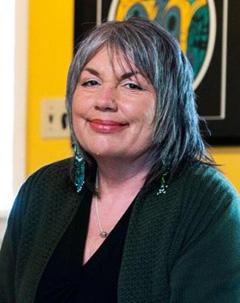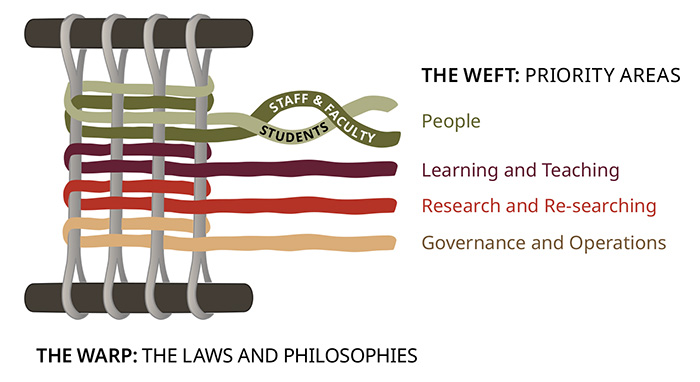The Coast Salish Weaving Framework
The SIÁM SȽEȽWÁȽ NOṈET SWEꞢE,Ƚ | Highly Respected One’s Peace of Mind at Last Coast Salish woven blanket, created by Myrna Crossley, is made with the intention of sharing values and teachings of the land, including using plants from the local territory to create natural dyes.
Myrna’s husband, the late Master Coast Salish carver and artist TEMOSEṈ-ŦET, Dr. Charles Elliott (Tsartlip First Nation), talked about how art is an act of resurgence and resistance, and that by weaving blankets, including this blanket, the wet moldy blanket of oppression and colonization is being lifted off their backs and being replaced with a blanket that belongs to their culture.

I feel fortunate to have been taught a skill that my ancestors practiced and with every blanket I weave I learn something new. It is a practice that requires you to be of a good mind and spirit when working; otherwise the wool does not work with you.
The warp & the weft

Blankets are woven on traditional upright Salish looms with stationary bars that are secured horizontally on the top and bottom of the frame. There is one movable floating horizontal bar in the middle that is held by the warped wool. The wool that wraps vertically around the upper, lower and floating bars of the frame is the warp and the wool that is woven horizontally across is called the weft.
The Laws and Philosophies form the warp of this plan, structuring and grounding our work to come. Strengthened by the teachings and woven across the warp, our priority areas form the weft of the plan. To better align with the teachings, and recognizing the interconnectedness of how we work together as a university community, the five strands of the first Indigenous plan have been re-articulated as the four strands of the weft.
People
We prioritize personal wellness, a sense of inclusion and belonging, and lifelong learning through all we do in our roles and relations as learners, teachers, collaborators, researchers, community members, alums and leaders. These priorities reflect the needs of students, including all learners, whether full-time or part-time, on-campus or off-campus, in credit or non-credit courses; staff; and faculty, including sessional and community instructors, and teaching assistants. We call attention to the work that needs to be done to support the diverse ways that people come to the university.
Learning and Teaching
We commit to offering a range of academic programs enriched by opportunities to engage with diverse forms of knowledge and to take learning and teaching beyond the classroom. In addition to integrating Indigenous ways of knowing and being, languages and pedagogies, we prioritize accessible programming that responds to community interests and needs.
Research and Re-Searching
As a place for scholarship, professional practice, artistic expression and community engagement, we commit to supporting relationships and creating an environment where Indigenous ways of knowing and being can thrive. Re-search, a term borrowed from Kathleen E. Absolon's [Minogiizhigokwe] Kaandossiwin: How we Come To Know: Indigenous Re-Search Methodologies (2011), means “to search again from our own location and to search again from our own ways” (p.21), by re-writing, re-storying and healing ourselves through the process of regenerating the knowledge that was taken through colonization.
Governance and Operations
Achieving these high-level aspirations to transform how we work together and to align the university with local Indigenous laws and protocols requires the collaboration and leadership of all faculties, divisions, schools, departments and units, and the reshaping of institutional structures. As a community, we hold ourselves responsible to each other and to the work of transforming university systems, and in our implementation of this Indigenous Plan.
Learn about the Indigenous Plan goals and priorities.
